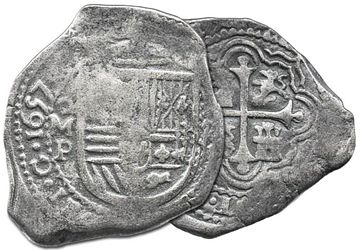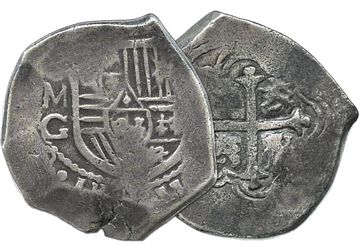The Brothers Bezerra: A Tale of Two Assayers
by Daniel Sedwick and Agustín García-Barneche
In Daniel Sedwick’s The Practical Book of Cobs Gerónimo Bercerra is listed as assayer for Mexican cobs from 1666 to 1677. However, the name ‘Bercerra” is not known in Spanish, whereas ‘Becerra”, spelled in old documents as ‘Bezerra’ is, so we set out to find out which was correct.
We found a thesis entitled Tres Constructores de Obras Científico-Técnicas de Minería y Metalurgia en la Nueva España del Siglo XVII: Luis Berrio de Montalvo, Jerónimo de Becerra y Juan del Corro (Three Developers of Scientific-Technical Works on Mining and Metallurgy in New Spain during XVII Century: Luis Berrio de Montalvo, Gerónimo de Becerra y Juan del Corro), written in 2000 by María Luisa Rodríguez-Sala for the Instituto de Investigaciones Sociales of the Universidad Nacional Autónoma de México (UNAM)available in the USMexNA online Library. It is an advanced paper in the broad area of mining and metallurgy that has obvious connections to assaying. Just nobody bothered to look there for information about mint assayers. Like so many other fields, numismatics tends to ignore related fields and fills the gaps in information with what we see on the coins themselves

Mexico City, Mexico, cob 8 reales, 1657 P (Sedwick Auction #6, lot #697)
In this case, however, the coins in question are among the most common and obvious of all Mexican silver cobs. In every edition of every book on cobs and assayers we have ever seen, there is no mention of a name for assayer P of the mid-1600s (1634-1666). The coins in question comprise the bulk of finds from two major shipwrecks (the Concepción of 1641 and the Maravillas of 1656) and from countless hoards and finds around the world. The coins very typically show a clear and large “oMP” next to the shield, and, in the early 1650s at least, very often show a surprisingly clear date in the peripheral legend. To finally have a name for this assayer means we can fully attribute hundreds of thousands of coins for the first time.

Mexico City, Mexico, cob 8 reales, Charles II, assayer G (Sedwick Auction #6, lot #702)
The research paper focuses on Gerónimo Becerra and his technical contributions to metallurgy. As a “renaissance man” of sorts, Becerra was a scientist, not only in the field of metallurgy but also in medicine, at least as it was defined in the 17th century. His work Anathomia Philosóphica (Philosophical Anatomy) was an important text in its time relating to psychology, in which Becerra explained intellectual, sensitive and emotional activities linked to the composition and operation of the five senses. As we know, however, he was not a medical doctor by trade but a coin assayer at the Mexican mint, as well as a technical researcher relating to that profession. By order of the mint, in 1671 he wrote a 24-page paper entitled Breve relacion del ensaye de plata y oro (Brief relation of the assaying of silver and gold), a sort of training manual for performing assays written in a very baroque and flowery fashion. Note especially that he mentions gold, which was not being coined at the time. The silver coins produced during his tenure as assayer are marked with a large G for Gerónimo under the oM mintmark, which is seen for the dates 1666 through 1677. According to Ms. Rodríguez-Sala’s thesis, Becerra died on 15 February 1677, which, incidentally, explains why coins of that date with his initial are so rare.
But even more important was how Becerra got the job as assayer in the first place. According to the thesis, Gerónimo had an older brother, Pedro, who was assayer before him and in fact passed the office to him due to illness. While nothing further about Pedro could be found in Ms. Rodríguez-Sala’s paper (for he was not a pioneer in metallurgy like his younger brother was later), this was enough to fill a huge void in Spanish colonial numismatics. Assayer P of 1634-1666 now had a name: Pedro Bezerra!
We can make three further observations from this new information. First of all, we see yet another instance of an assayer using his first name and not his last name for his initial on the coins, but we believe that habit is coincidental and has more to do with the fact that G and P were standard letter punches in the mint’s kit, since they were used in the words of the legends, whereas B was not. Second, Gerónimo Bezerra’s advanced technical study helps us appreciate that assayers were important officials in charge of serious metal-testing and not just figureheads or minters hammering the coins. Finally, we wonder if the fact that Gerónimo Bezerra was such an advanced metallurgist and published scientist had anything to do with the decision to begin minting gold coins in Mexico in 1679. Surely given the delays in communication he must have had some role in the innovation, and perhaps he even planned to mint the first gold coins before he died suddenly.
In any case we now have some answers where before we had a guess and a blank. Assayer P was Pedro Bezerra (1634-1666), and assayer G was Gerónimo Bezerra.
| Initial | Name | Began on | Left office on |
| P | Pedro Bezerra | 1634 | 1666 |
| G | Gerónimo Bezerra | 1666 | 1677 |
